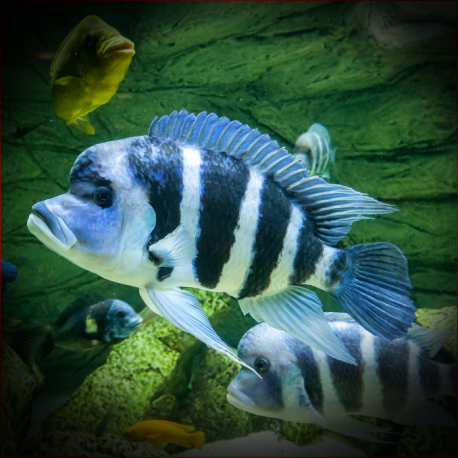More info
Datasheet
| Minimum Tank Size | 850 litres / 224.55 US gallons |
| Maximum Size | 25.5cm / 10.04inches |
| Temperature | 23°C / 73.40°F - 27°C / 80.60°F |
| Hardness | 10.03dgH / 179ppm - 25.04dgH / 447ppm |
| pH | 8.0-9.0 |
General Description
Cyphotilapia Gibberosa, commonly known as Frontosa or Tanganyika Humphead, is a species of cichlid belonging to the Cichlidae family. It is characterized by a hump on the forehead and broad vertical bands on the body, with distinguishing features from its only congener, Cyphotilapia Frontosa.
Aquarium Setup
A suitable aquarium setup for Cyphotilapia Gibberosa includes a well-structured tank with sheltered areas and open space. The habitat can consist of a sandy substrate, water-worn rocks forming cave-like structures, and large boulders. Providing structures of varying sizes is essential, with careful attention to avoiding sharp edges to prevent injuries. Water quality is crucial, requiring hard, alkaline conditions and a stable environment achieved through proper filtration and regular water changes. Lighting preferences include somewhat murky conditions resembling their natural habitat.
Behaviour
Cyphotilapia Gibberosa is gregarious and thrives in groups of at least five, preferably ten or more specimens. Unlike many cichlids, males do not establish distinct territories but form a dominance hierarchy within the group. Alpha individuals emerge based on group size and available space, showcasing a unique social structure.
Feeding and Diet
This species is a general predator, feeding on smaller fishes, macro-invertebrates, molluscs, algae, and organic detritus. In captivity, they accept high-quality prepared foods, live or frozen Artemia, mosquito larvae, and shrimp. A balanced diet should contain vegetable matter like Spirulina, while mammalian or avian meat should be avoided due to potential health risks.
Reproduction & Dimorphism
Cyphotilapia Gibberosa is a maternal, ovophilous mouthbrooder commonly bred in aquariums. Adult males exhibit polygynous behavior and require several females for optimal breeding conditions. Sexual maturity is reached after several years, and successful breeding may involve low water movement, undergravel filtration, and buccal feeding of fry by the brooding female. Sexual dimorphism becomes apparent in adult males, growing larger with extended fins and a prominent nuchal hump.
Habitat and Distribution
Endemic to the southern region of Lake Tanganyika in East Africa, Cyphotilapia Gibberosa inhabits rocky, sediment-rich environments at depths of 6-120 meters. The species forms large aggregations with a preference for areas with few shelters, influencing their unique reproductive strategy. Popular localities for the species include regions in the Democratic Republic of the Congo, Zambia, and Tanzania, showcasing a diverse distribution within its endemic range.

